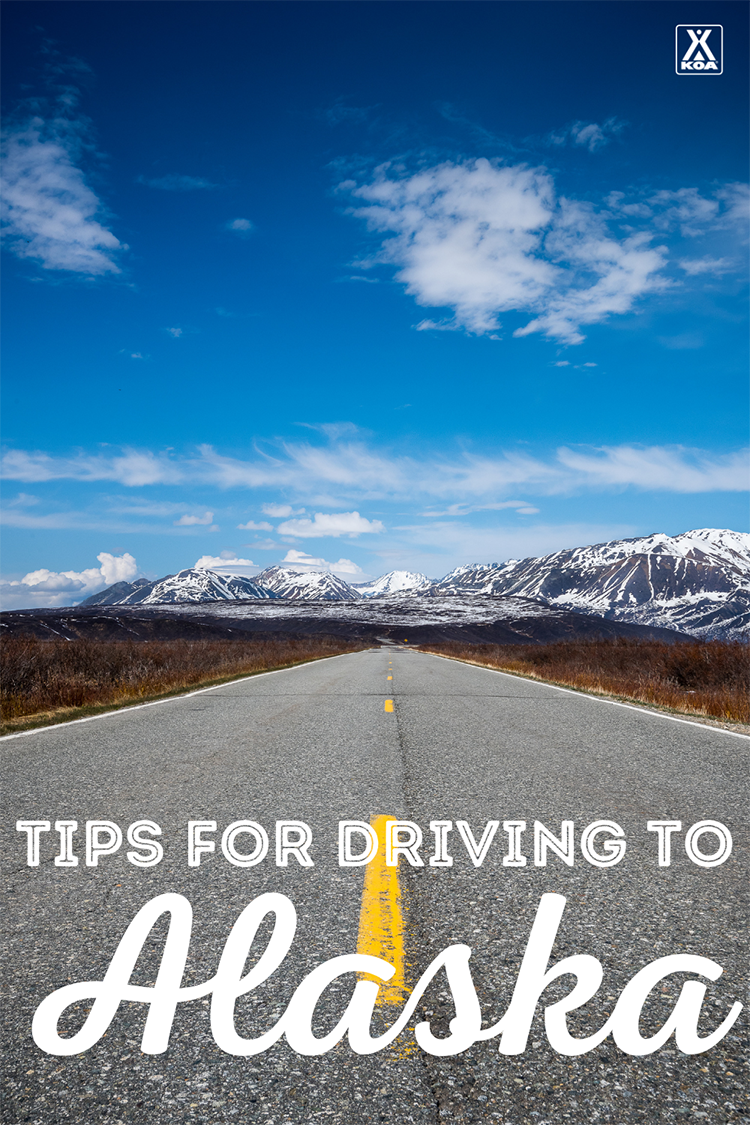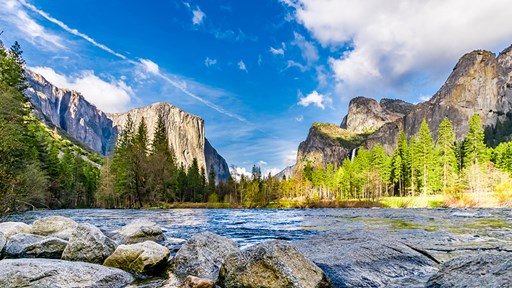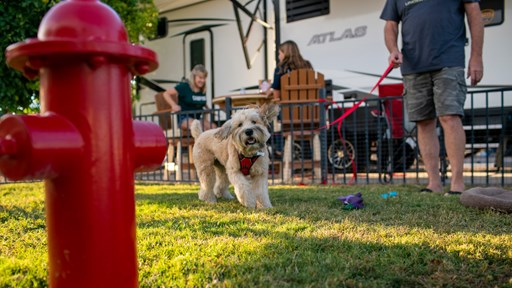With showstopping views, endless hiking trails and plenty of outdoor recreation, Alaska is the ideal vacation spot for travelers who cannot get enough of the great outdoors. RVing to Alaska is one of the best ways to travel safely, and oftentimes, the road trip to Alaska can be just as exciting as the final destination.
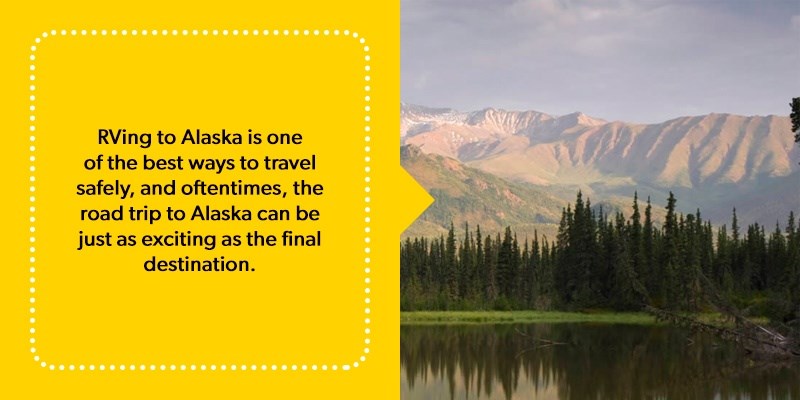
8 Tips for Driving Your RV to Alaska
To ensure a successful RV trip to Alaska, follow these eight tips.
1. Pack Your Bags
Your Alaska packing list will be slightly different from your typical camping gear list due to the variation in temperature and sunlight. Even in the summer months, there are chilly days in Alaska, and you should always plan for rain and snow, no matter the season. Additionally, winter days in Alaska are short, with northernmost locations going around two months without daylight. During the summer, however, the days are long. For cities such as Homer, the sun sets after 11 p.m., so take that into consideration when selecting your travel dates.
With this information in mind, here is what you should include on your Alaska RV packing list:
- Clothing: Make sure you pack clothing that is easy to layer without overheating. Lightweight shirts, insulated winter coats, a rain jacket, waterproof hiking boots, a hat, scarf, gloves and several pairs of wool socks are always good to have on hand.
- Hiking equipment: Many travelers RV to Alaska to explore the parks and hike near breathtaking glaciers. Make sure you have all the equipment you need, including a daypack, water bottle, a compass if traveling without a guide, a portable first aid kit, insect repellant, sunscreen and anything else that will keep you safe on the trails.
- Fishing supplies: If you are heading to the Last Frontier to try some sportfishing, always check for local fishing regulations and license requirements before you leave.
- Camping essentials: No matter where you travel, there are some camping essentials you should always bring with you, including comfortable chairs, kitchen supplies and a camera.
- Indoor entertainment: There is plenty to do in Alaska during inclement weather, but it never hurts to have some indoor entertainment for your journey. Bring along your favorite book or board games to keep the family entertained during any downtime.
- Travel supplies: To make your trip safer and more comfortable, always have plenty of travel supplies. Have plenty of toll money ready if traveling on toll roads, have a paper map in case your GPS stops working and never go to Alaska without extra blankets in tow. If visiting during the summer, you may also want to invest in darkening curtains for your rig if you have trouble sleeping.
2. Ready Your Rig
Once your bags are packed, it is time to get your RV ready for the trip:
- Check insulation: Make sure your windows and doorways are sealed to prevent fluctuating temperatures inside your RV. Apply caulking around windows and doors where necessary, and consider hanging detachable curtains. Choose a thick, RV-sized rug to help absorb cold air. On the outside of your RV, look into available RV skirting options.
- Schedule an inspection: Before any road trip, you should have your RV inspected to make sure all parts — including your furnace and water heater — are working correctly. Once your ride has been inspected, double-check all tires and pump them full of air, get an oil change and keep your fuel tank at least half full at all times.
- Secure breakables: Road trips can get bumpy, so always secure your belongings before heading out. Pad breakable items, like dishware, and tie your cabinet doors and refrigerator closed to keep things in place.
- Remember emergency equipment: Never leave home without emergency road equipment, including a spare tire for your RV, tire chains, a flashlight, a first aid kit, an RV tool and repair kit with tire patches, high-visibility gear, a tow strap, a vehicle jack, an ice scraper and snow shovel, jumper cables and emergency flares.
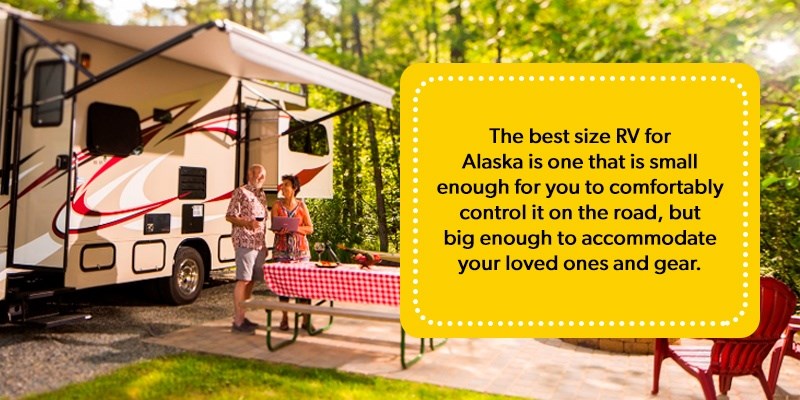
Before you hit the road, make sure you know everything about your RV, including how tall it is. The best size RV for Alaska is one that is small enough for you to comfortably control it on the road, but big enough to accommodate your loved ones and gear. Knowing the height of your rig is vital for passing through tunnels and other areas of low clearance. You should also know the weight of your loaded RV and whether you are required to stop at weigh stations along your journey.
3. Map Your Route
Map your travel route before you leave to avoid potential roadblocks, like closed roads or toll booths. Make sure your route includes regular stops to gas stations and eateries. Locate all free and safe overnight parking options, or plan to lodge at places like Kampgrounds of America along the way. The cost of an Alaska RV trip will depend on several factors, but planning your route ahead of time will also help you prepare and maintain a travel budget.
The Alaska Highway is the only way to get into Alaska from the lower 48, and there are two different travel routes you can take to get there: either from the start of the Alaska Highway in Dawson Creek, British Columbia or via the Stewart-Cassiar Highway. The Cassiar Highway often provides the quickest access and offers a close look at some beautiful scenery, but choose the route that makes the most sense for your journey and starting point.
4. Practice Safe Winter Driving
Alaska roadways can be rife with snow and ice, so it is crucial that you are prepared to drive your RV on potentially hazardous roadways:
- Maintain a slow and steady speed.
- Be vigilant of wet roadways and black ice.
- Increase your following distance between other vehicles.
- Keep your gas tank full to avoid breakdowns and keep your tank insulated.
- Allow yourself extra time to reach your destination.
- Know when to pull off the road, such as during inclement weather.
- Remember, your RV is much larger than the car you drive for your everyday commute or outings. When RVing to Alaska, always take into account the height, weight and length of your rig as you navigate bridges, tunnels and narrow roads.
5. Enjoy the Ride
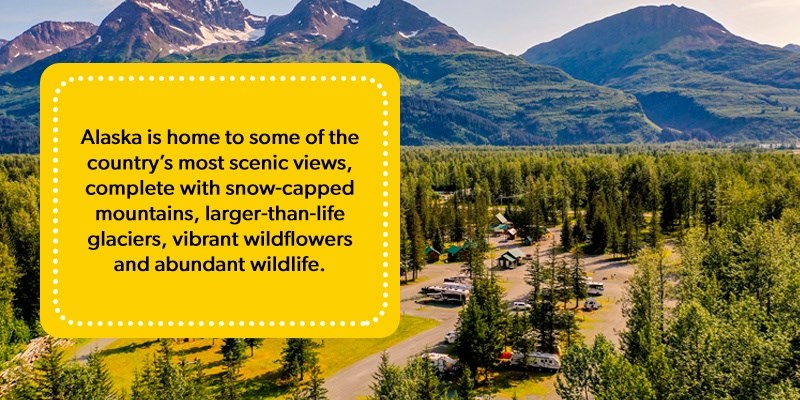
Alaska is home to some of the country’s most scenic views, complete with snow-capped mountains, larger-than-life glaciers, vibrant wildflowers and abundant wildlife. When planning to drive your RV to Alaska, pad your schedule with enough time to enjoy the ride. Take detours when it is safe to do so, experience the area’s culture where you can and always try the local cuisine when presented with the opportunity. If you encounter wildlife while on the road — specifically bears, moose and wolves — never get out of your vehicle or otherwise approach these animals. Maintain a safe distance at all times and never feed or harass them.
6. Be Prepared to Cross the Border
Because traveling from the lower 48 states to Alaska requires driving through Canada, you need to be prepared to cross the border. You will have to do this more than once — when you enter Canada and when you enter the United States. Ensure you are ready with the following:
- Necessary documentation: To cross the border, you need a valid passport for everyone traveling, current vehicle registration for your RV and a valid driver’s license.
- Be prepared to answer questions: Border patrol will likely have some questions for you, so do not be alarmed. They might ask questions about your reason for traveling, your destination and may ask to inspect your vehicle.
- Know what you cannot bring: Both Canada and the United States have a list of restricted items they do not allow past the border, including firearms, some types of food, alcohol, firewood and several other things. Always check these requirements if you have questions about a specific item.
Please note that the border crossing process can take a long time, so always check wait times and adjust your schedule accordingly.
7. Know the Rules for Traveling With Pets or Minors
If there are minors in your family or you are bringing along your favorite four-legged friend, there are some special requirements you must keep in mind:
- When traveling with minors: When a minor under the age of 16, who is also a U.S. citizen, is traveling to Canada, they must have a copy of their birth certificate and a valid passport. Unless both parents are traveling with the minor, they must also have a notarized letter from the absent parents stating they acknowledge and give permission for their child to travel outside of the country with another adult.
- When traveling with pets: When traveling with pets, be aware that there are some animal restrictions. Certain pets, like snakes, birds or insects, may not be able to cross a border. Depending on your pet’s age, you should have all documentation associated with your pet, including a health certificate from a licensed veterinarian and proof of current rabies vaccination. You should also make sure your pet is microchipped or wearing an identification tag with your contact information on it. Take a picture of your pet to have in case they get loose, and you need to recruit help searching for them.
8. Find an RV-Friendly Campground
Finally, make sure your Alaskan destination has an RV-friendly campground available, such as a KOA. KOA has both Pull-Thru and Back-In RV Sites, so you can park your rig in the way most convenient to you. If you require electricity, KOA also has amp-connectivity available. If you plan to visit Alaska during the peak summer season, try to reserve a campsite ahead of time. Alaska is a popular tourist destination, and campgrounds may fill quickly.
KOA Is Your Gateway to Alaskan Adventure
Are you ready for RV adventure of a lifetime? KOA has locations in three of the most popular Alaskan destinations, including Homer and Baycrest, Seward and Valdez. For the ultimate Alaskan experience, plan to stay a few nights in each campground so you can truly immerse yourself in all of the state’s recreational and scenic opportunities.
